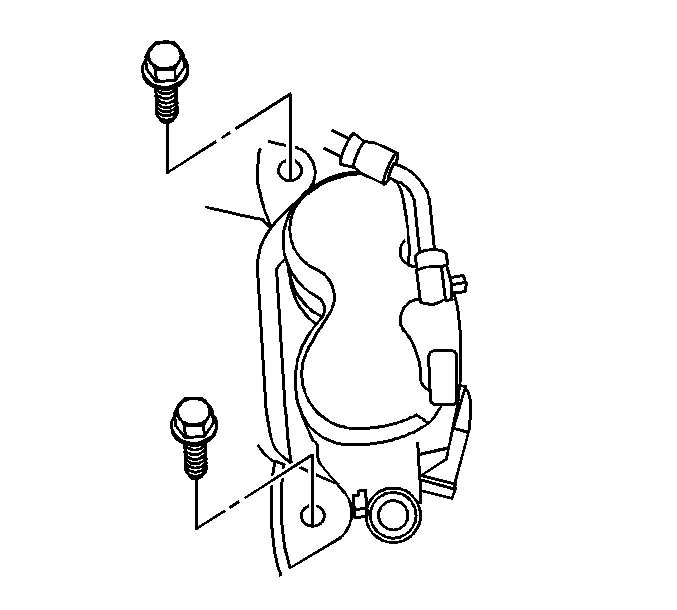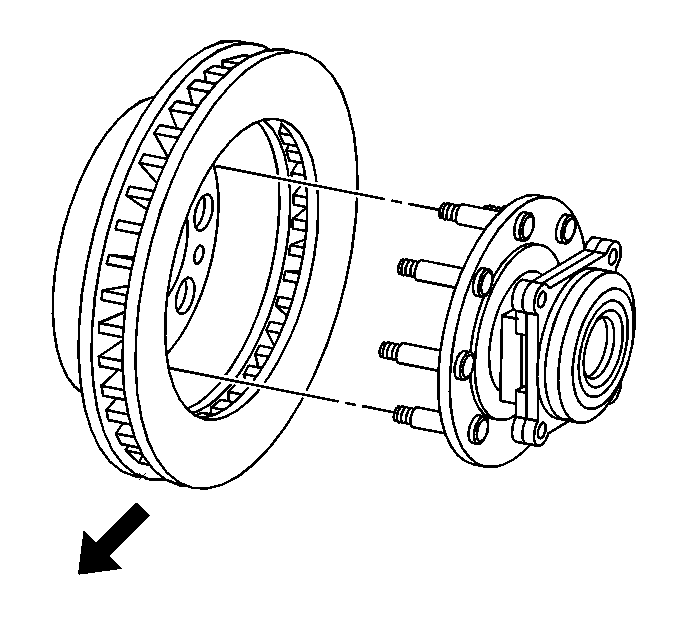Tools Required
Caution: Refer to Brake Dust Caution in the Preface section.
Removal Procedure
Notice: Any new rotor must have the protective coating removed from the friction surfaces before being placed in service. Remove the protective coating using
denatured alcohol or an equivalent brake cleaner, and wipe the surface clean with clean cloths. Do not use gasoline, kerosene, or other oil base solvents which may leave an oily residue. This residue is damaging to the brake lining and is flammable.
- Raise and suitably support the vehicle. Refer to
Lifting and Jacking the Vehicle
in General Information.
- Remove the tire and wheel assembly. Refer to
Tire and Wheel Removal and Installation
in Tires and Wheels.
- Mark the relationship of the rotor to the hub.

- Remove the 2 brake caliper bracket mounting
bolts.
Notice: Support the brake caliper with heavy mechanic wire, or equivalent,
whenever it is separated from its mount and the hydraulic flexible brake hose is still connected. Failure to support the caliper in this manner will cause the flexible brake hose to bear the weight of the caliper, which may cause damage to the brake hose and
in turn may cause a brake fluid leak.
- Remove the brake caliper and brake caliper mounting bracket as
an assembly and support with heavy mechanic's wire or equivalent. DO NOT disconnect
the hydraulic brake flexible hose from the caliper.
- Remove the rotor retaining push nuts from the wheel studs, if applicable.
- It may be necessary to strike the end of the hub or the rotor with a
deadblow hammer to separate the rotor from the hub.

- Remove
the rotor.
- If the rotor is difficult to remove due to corrosion in the hub area
use the following procedure to remove the rotor; 25 series only.
| • | Clean all the surface areas and the threaded holes of contamination. |
| • | Generously apply penetrating oil or the equivalent to the hub/rotor area. |
| • | Insert (2) M10 x 1.5 bolts (jack screws) into the threaded
holes of the rotor. |
| • | Tighten both bolts evenly to force the rotor from the hub. |
Installation Procedure
Notice: Whenever the brake rotor has been separated from the wheel bearing flange,
clean any rust or foreign material from the mating surface of the rotor and
flange with the J 42450 hub cleaning kit. Failure to do
this may result in increased lateral runout of the rotor and brake pulsation.
- Use the J 42450-A
to clean all rust and contaminants from the mating surface of the hub flange.
- Use the J 41013
to
clean all rust and contaminants from the inside diameter of the hat section of
the brake rotor to prevent any foreign material from getting between the brake
rotor and the hub flange.
Important: If the rotor was removed using the jack screw method you must ensure that the
hub flange is free of nicks or marks caused by this procedure. Remove all raised
nicks or marks before installing the rotor.

- Align
the rotor to its original position on the hub, if applicable, and install the rotor.
- Install the caliper and caliper mounting bracket assembly.
- Perform the following procedure before installing the brake caliper bracket
mounting bolts.
| • | Remove all traces of the original adhesive patch. |
| • | Clean the threads of the bolt with brake parts cleaner or the equivalent
and allow to dry. |
| • | Apply Threadlocker GM P/N 12345493 (Canadian P/N 10953488)
to the threads of the bolt. |

Notice: Use the correct fastener in the correct location. Replacement fasteners
must be the correct part number for that application. Fasteners requiring
replacement or fasteners requiring the use of thread locking compound or sealant
are identified in the service procedure. Do not use paints, lubricants, or
corrosion inhibitors on fasteners or fastener joint surfaces unless specified.
These coatings affect fastener torque and joint clamping force and may damage
the fastener. Use the correct tightening sequence and specifications when
installing fasteners in order to avoid damage to parts and systems.
- Install the 2 caliper bracket mounting bolts.
Tighten
| • | Tighten the brake caliper bracket mounting bolts to 175 N·m
(121 lb ft), 15 Series. |
| • | Tighten the brake caliper bracket mounting bolts to 300 N·m
(221 lb ft), 25 Series. |
- Install the tire and wheel assembly. Refer to
Tire and Wheel Removal and Installation
in Tires and Wheels.
- Lower the vehicle.
- With the engine OFF, gradually apply the brake pedal to approximately
2/3 of its travel distance.
- Slowly release the brake pedal.
- Wait 15 seconds, then repeat steps 9-10 until a firm pedal is obtained.
This will properly seat the brake caliper pistons and brake pads.
- Fill the master cylinder reservoir to the proper level with clean brake
fluid. Refer to
Master Cylinder Reservoir Filling
in Hydraulic Brakes.




